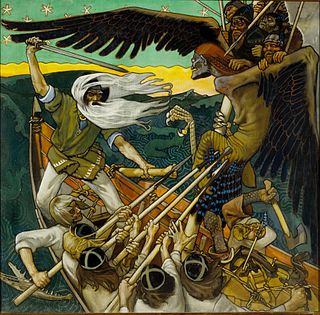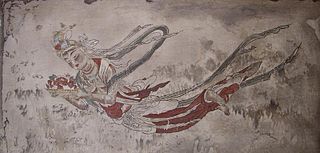Related Research Articles

In mythology, folklore and speculative fiction, shapeshifting is the ability to physically transform oneself through unnatural means. The idea of shapeshifting is found in the oldest forms of totemism and shamanism, as well as the oldest existent literature and epic poems such as the Epic of Gilgamesh and the Iliad. The concept remains a common literary device in modern fantasy, children's literature and popular culture. Examples of shapeshifters are vampires and werewolves.

Deer have significant roles in the mythology of various peoples located all over the world, such as object of worship, the incarnation of deities, the object of heroic quests and deeds, or as magical disguise or enchantment/curse for princesses and princes in many folk and fairy tales.

Tennin, which may include Tenshi, Ten no-Tsukai, Hiten and the specifically female version, the Tennyo, are a divine kind of spiritual beings found in Japanese Buddhism, the equivalent of angels. They were seemingly imported from Chinese Buddhism, which was itself influenced by the concepts of heavenly beings found in Indian Buddhism and Chinese Taoism.

The samodiva, samovila or vila, are woodland fairies or nymphs found in South and West Slavic folklore.

The Frog Princess is a fairy tale that has multiple versions with various origins. It is classified as type 402, the animal bride, in the Aarne–Thompson index. Another tale of this type is the Norwegian Doll i' the Grass. Eastern European variants include the Frog Princess or Tsarevna Frog and also Vasilisa the Wise ; Alexander Afanasyev collected variants in his Narodnye russkie skazki, a collection which included folk tales from Ukraine and Belarus alongside Russian tales.

The "swan maiden" story is a name in folkloristics used to refer to three kinds of stories: those where one of the characters is a bird-maiden, in which she can appear either as a bird or as a woman; those in which one of the elements of the narrative is the theft of the feather-robe belonging to a bird-maiden, though it is not the most important theme in the story; and finally the most commonly referred to motif, and also the most archaic in origin: those stories in which the main theme, among several mixed motifs, is that of a man who finds the bird-maiden bathing and steals her feathered robe, which leads to him becoming married to the bird-maiden. Later, the maiden recovers the robe and flies away, returning to the sky, and the man may seek her again. It is one of the most widely distributed motifs in the world, most probably being many millennia old, and the best known supernatural wife figure in narratives.

Eglė the Queen of Serpents, alternatively Eglė the Queen of Grass Snakes, is a Lithuanian folk tale, first published by M. Jasewicz in 1837.

Go I Know Not Whither and Fetch I Know Not What is a Russian fairy tale collected by Alexander Afanasyev in Narodnye russkie skazki.

Dong Yong and the Seventh Fairy is a Chinese legend centered around a romance between an orphaned Han-dynasty man named Dong Yong and the Seventh Fairy, the youngest daughter of the Jade Emperor.

Na Gruagaichean is one of the Mamores mountains in the Scottish Highlands, between Glen Nevis to the north and the village of Kinlochleven to the south. It has twin peaks, the highest of which rises to 1,056 m (3,465 ft), and it is classed as a Munro. The mountain is one of the most accessible from the village, due in part to its nearness and a well-defined path leading most of the way to the summit.
Vietnamese mythology comprises folklore, national myths, legends, or fairy tales from the Vietnamese people with aspects of folk religion in Vietnam. Vietnamese folklore and oral traditions may have also been influenced by historical contact with neighbouring Tai-speaking populations, other Austroasiatic-speaking peoples, as well as with people from the region now known as Greater China.

The Cowherd and the Weaver Girl are characters found in Chinese mythology and appear eponymously in a romantic Chinese folk tale. The story tells of the romance between Zhinü and Niulang. Despite their love for each other, their romance was forbidden, and thus they were banished to opposite sides of the heavenly river. Once a year, on the seventh day of the seventh lunar month, a flock of magpies would form a bridge to reunite the lovers for a single day. Though there are many variations of the story, the earliest-known reference to this famous myth dates back to a poem from the Classic of Poetry from over 2600 years ago:
Tulisa, the Wood-Cutter's Daughter is an Indian legend published as an annex to Somadeva Bhaṭṭa's work, related to Cupid and Psyche.

Ileana Simziana or Ileana Sînziana is a Romanian fairy tale collected and written down by Petre Ispirescu between 1872 and 1886. It tells the story of an unnamed youngest daughter of an emperor, who dresses up as a man, goes to serve another emperor and rescues the titular princess Ileana. During a quest of obtaining the Holy Water she is hit by a curse of a monk that causes her to transform into a man - Făt-Frumos, who marries Ileana in the happy ending.
Namu doryeong is a Korean orally transmitted folktale that tells the story of the son of a tree and a seonnyeo (fairy). While riding on his father, the tree, during a great flood, the boy rescues disaster-stricken animals, marries the daughter of an old woman and becomes the progenitor of humanity. The pattern of a boy with an earthly father and heavenly mother ("地父天母") founding a new human race after the previous one is wiped out in a flood lends Namu doryeong the characteristics of a human foundation myth.
Ureongi gaksi is a Korean folktale about a poor man who breaks taboo and marries a maiden who comes out of a snail shell until he loses his snail bride when a magistrate kidnaps her. The tale features an inter-species marriage in which a snail transforms into a woman and becomes the bride of a male human. The tale also depicts the motif of a government official from the ruling class taking away a woman in a relationship with a lower-class male civilian.
The Turtle Prince or The Tortoise Prince is a group of South Indian and Sri Lankan folktales in which a prince in turtle form marries a human princess. Scholars like Stith Thompson, Warren Roberts and Stuart Blackburn have related the story and variants to the international cycle of the Animal as Bridegroom.
The Fire Boy is a Japanese folktale collected by scholar Seki Keigo. It tells of a boy expelled from home to another realm and, thanks to the efforts of a faithful horse, marries a lord's daughter.
The Goose Wife is a mythical female character that appears in tales from the Inuit and other ethnic groups that dwell across the circumpolar Arctic region. The usual story is that the geese alight on land, become women by taking off their goose-skins and bathe in a lake. However, they are unaware that a human hunter is spying on them, and he steals the goose-skin of one of them, forcing her to be his wife. Due to the great similarities between both characters, the goose wife has been compared to the swan maiden, another female that alternates between human and bird forms.

Hassan of Basra is a folktale associated with the Arabian Nights, a compilation of Persian and Arabic folktales. Similar stories are attested in the same collection: Janshah and Mazin of Khorassan.
References
- ↑ Chang, Duk-soon. The Folk Treasury of Korea: Sources in Myth, Legend and Folktale. Ed. Republic of Korea: Society of Korean Oral Literature. 1970. p. 17.
- ↑ Grayson, James Huntley (2001). Myths and legends from Korea: an annotated compendium of ancient and modern materials. Richmond, Surrey: Curzon Press. p. 371.
- ↑ Zŏng, In-sŏb (1983). A guide to Korean literature. Elizabeth, N.J.: Hollym International Corp. p. 163.
- ↑ Yang, JS. (2024). "A Fairy and A Woodcutter". In W.C. Turgeon (ed.). The Philosophical Power of Fairy Tales from Around the World. Cham: Palgrave Macmillan. p. 230. doi:10.1007/978-3-031-60373-0_17. ISBN 978-3-031-60372-3.
"A Fairy and A Woodcutter" is a Korean folktale which has spread across countries. Similar tales are told around the world, such as the German "Swan Maiden" and the Japanese "Fairy's Robe."
- ↑ Chang, Duk-soon. The Folk Treasury of Korea: Sources in Myth, Legend and Folktale. Ed. Republic of Korea: Society of Korean Oral Literature. 1970. pp. 167–173.
- ↑ American Myths, Legends, and Tall Tales: An Encyclopedia of American Folklore. Vol. 3: Q-Z. Fee, Christopher R. and Webb, Jeffrey B. (eds.). Santa Barbara, California; Denver, Colorado: ABC-CLIO. 2016. pp. 1063–1064. ISBN 978-1-4408-5137-7.
- ↑ The National Folk Museum of Korea (South Korea). Encyclopedia of Korean Folk Literature: Encyclopedia of Korean Folklore and Traditional Culture Vol. III. 길잡이미디어, 2014. pp. 281-282.
- 1 2 King, Ross (2005). "Traditional Korean Fairy Tales and Contemporary Korean Fiction: A Case Study of 'The Woodcutter and The Nymph'". Acta Koreana. 8 (2): 17–48. Project MUSE 804895.
- ↑ Folk tales from Korea. Elizabeth, N.J.: Hollym International Corp. 1982. pp. 21–25.
- ↑ Yang, JS. (2024). "A Fairy and A Woodcutter". In W.C. Turgeon (ed.). The Philosophical Power of Fairy Tales from Around the World. Cham: Palgrave Macmillan. pp. 229–230. doi:10.1007/978-3-031-60373-0_17. ISBN 978-3-031-60372-3.
- ↑ Suzanne Crowder Han, ed. (1991). Korean Folk & Fairy Tales. Hollym. pp. 101–106. ISBN 9780930878030.
- ↑ Aarne, Antti; Thompson, Stith. The types of the folktale: a classification and bibliography. Folklore Fellows Communications FFC no. 184. Helsinki: Academia Scientiarum Fennica, 1973 [1961]. pp. 128–129.
- ↑ 김환희 (December 2007). "Problems and Prospects for Comparative Scholarship on the 'Swan-Maiden' Tales of Korea and Japan". Yeol-sang Journal of Classical Studies (26): 85–116. doi: 10.15859/yscs..26.200712.85 .
- ↑ Yang, JS. (2024). "A Fairy and A Woodcutter". In W.C. Turgeon (ed.). The Philosophical Power of Fairy Tales from Around the World. Cham: Palgrave Macmillan. p. 231. doi:10.1007/978-3-031-60373-0_17. ISBN 978-3-031-60372-3.
- ↑ Yang, JS. (2024). "A Fairy and A Woodcutter". In W.C. Turgeon (ed.). The Philosophical Power of Fairy Tales from Around the World. Cham: Palgrave Macmillan. p. 231. doi:10.1007/978-3-031-60373-0_17. ISBN 978-3-031-60372-3.
- ↑ Lee Si-Jun (September 2018). "일본의 〈천인각시天人女房〉담의 「지상체재형」「천인승천형」에 관한 고찰 -한국의 〈나무꾼과 선녀〉와의 비교를 통하여-". Journal of Japanese Studies (77): 109–135. doi: 10.15733/jast.2018..77.109 . S2CID 240276087.
- ↑ Grayson, James Huntley (2001). Myths and legends from Korea: an annotated compendium of ancient and modern materials. Richmond, Surrey: Curzon Press. p. 371.
- ↑ Elswit, Sharon (2009). The East Asian story finder: a guide to 468 tales from China, Japan and Korea, listing subjects and sources. McFarland. p. 79. ISBN 978-0-7864-3945-4.
- ↑ Chang, Duk-soon. The Folk Treasury of Korea: Sources in Myth, Legend and Folktale. Ed. Republic of Korea: Society of Korean Oral Literature. 1970. p. 17.
- ↑ Riordan, James (2000) [1994]. Korean Folk-tales. Oxford Myths and Legends. Oxford: Oxford University Press. pp. 21–30.
- ↑ Tangherlini, Timothy R. (August 1995). "Korean Folk-tales. By James Riordan. Oxford Myths and Legends. Oxford: Oxford University Press, 1994. 133 pp. $10.95 (paper)". The Journal of Asian Studies. 54 (3): 856–858. doi:10.2307/2059476. JSTOR 2059476. S2CID 176878624.
- ↑ Kim, So-un (1955). The story bag; a collection of Korean folk tales. Rutland, Vt.: Tuttle. pp. 86–98.
- ↑ Jewett, Eleanore Myers (1959). Which was witch?: tales of ghosts and magic from Korea. New York: Viking. pp. 109–123.